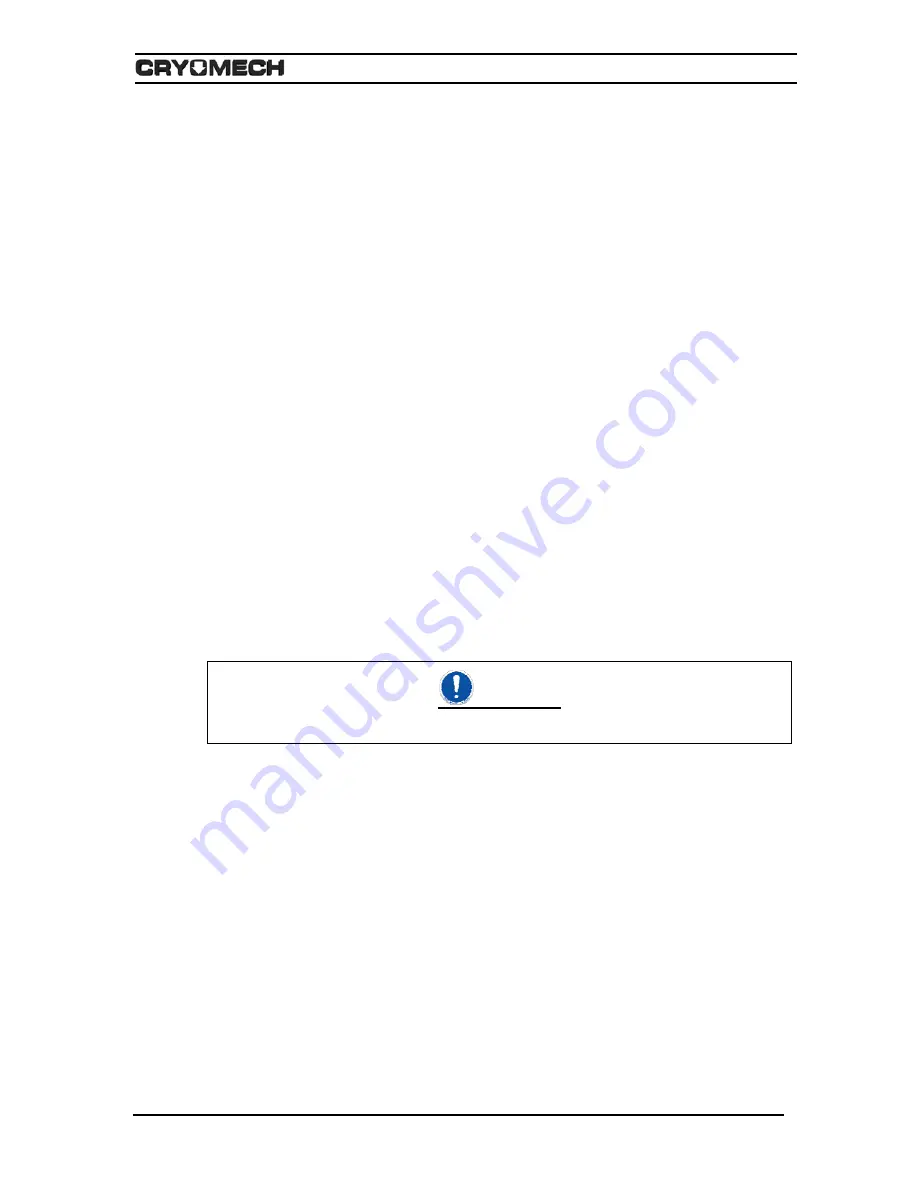
Operation
7-6
7.5 Normal operation behavior
On initial start up, with the entire system at room temperature, normal helium compressor
pressures are in the range of 70 to 85 PSIG (4.8 to 5.9 bar) on the low pressure gauge
and 290 to 320 PSIG (20 to 22.1bar) on the high pressure gauge.
When operating properly, the cold head will emit a rhythmic squeak or chirp
approximately 144 times per minute for 60Hz systems or 120 times per minute for 50 Hz
systems. This noise is an indication of the proper flow of helium gas within the system.
The cold head will begin to condense nitrogen inside the dewar within 15 minutes of start
up. The liquid nitrogen will drip off the cold head and fall to the bottom of the dewar. The
liquid nitrogen evaporates when it contacts the dewar, slowly cooling the dewar to liquid
nitrogen temperature. The dewar will take approximately 4 hours to cool. Once the dewar
is cooled, liquid nitrogen will begin to accumulate in the dewar.
The black needle on the level indicator/switch indicates the amount of liquid nitrogen in
the dewar. The level indicator/switch will shut the helium compressor off when the dewar
is full, placing the system in standby mode. The red
STANDBY
light, located on the
dewar, will illuminate when the level indicator/switch has shut the helium compressor off.
In addition, when the system is in standby mode, the
POWER
switch light on the helium
compressor will be off.
If the system is not running and the
STANDBY
light is not illuminated, then a malfunction
somewhere in the system has occurred. Refer to the Troubleshooting Section to
diagnose the problem.
The pressure inside the dewar will increase, due to the boil-off of the liquid nitrogen,
when the system is in standby mode. The pressure relief valve on the dewar will open
when the internal pressure in the dewar reaches approximately 10 PSIG. Frost and
condensation may accumulate near the relief valve when activated. If the dewar pressure
gauge shows a pressure greater than 15 PSIG, disconnect the nitrogen flex line from the
low pressure regulator and relieve the pressure through the bleed valve. The problem
must be diagnosed and corrected immediately.
CAUTION
A dewar pressure greater than 25 PSIG will destroy the level indicator/switch.
When the liquid nitrogen level in the dewar has dropped to the user specified level, the
level indicator/switch will automatically restart the system. When the system restarts, the
STANDBY
light will go out and the
POWER
switch light will illuminate.
With the dewar cooled to liquid nitrogen temperature, the air compressor can be used to
monitor how well the system is running. This is done by keeping a log of the length of
time the air compressor remains off. As the "off" times increase, the amount of liquid
nitrogen production decreases. Excessively long "off" periods between starts may
indicate a need for cold head or helium compressor service.
The compressed air filters must be monitored and maintained on a regular basis. Failure
to maintain the filter system properly will destroy the nitrogen generator.
The incoming compressed air temperature should be within 10
°
F (6
°
C) of the ambient air
temperature for optimal operation of the air filters. The maximum inlet air temperature is
125
°
F (52
°
C). If the incoming compressed air supply is not properly cooled, water vapor
will pass through the first two filters and condense in the carbon filter. If the system
continues to operate in this condition, the nitrogen generator will be destroyed and an
icing problem will develop in the dewar.
Summary of Contents for LNP-40
Page 1: ...Model LNP 40 Liquid Nitrogen Plant INSTALLATION OPERATION and ROUTINE MAINTENANCE MANUAL...
Page 4: ...1 1 N Section 1 Overview...
Page 10: ...2 1 N Section 2 Warranty...
Page 13: ...3 2 N Section 3 Safety...
Page 25: ...4 1 N Section 4 Inspection and Unpacking...
Page 29: ...5 3 N Section 5 Specifications...
Page 50: ...6 1 N Section 6 Installation...
Page 67: ...7 2 N Section 7 Operation...
Page 87: ...8 1 N Section 8 Routine Maintenance...






























